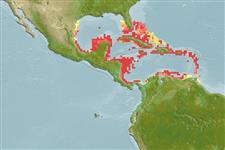Common names from other countries
Classification / Names / Names
Common names | Synonyms | Catalog of Fishes (gen., sp.) | ITIS | CoL | WoRMS
Environment: milieu / climate zone / depth range / distribution range
Ecology
Reef-associated; depth range 0 - 30 m (Ref. 83917). Tropical; 28°N - 9°N, 98°W - 60°W (Ref. 846)
Western Atlantic.
Length at first maturity / Size / Weight / Age
Maturity: Lm ? range ? - ? cm
Species forms the largest colonies of all Acropora, with parallel, obliquely inclined, very thick, tapered branches. Corallites are tubular and irregular in length. Axial corallites are indistinct. Color can either be tan or pale brown with white axial corallites.
Maximum depth from Ref. 116012.
Life cycle and mating behavior
Maturity | Reproduction | Spawning | Eggs | Fecundity | Larvae
Hermaphroditic (Ref. 113712). Mature gametes are shed into the coelenteron and spawned through the mouth. Life cycle: The zygote develops into a planktonic planula larva. Metamorphosis begins with early morphogenesis of tentacles, septa and pharynx before larval settlement on the aboral end (Ref. 833).
Wallace, C.C. 1999. (Ref. 86439)
IUCN Red List Status (Ref. 130435: Version 2024-1)
CITES status (Ref. 108899)
Not Evaluated
Human uses
| FishSource |
Tools
Internet sources
Estimates based on models
Preferred temperature
(Ref.
115969): 26.5 - 28.2, mean 27.5 (based on 464 cells).
Price category
Unknown.
